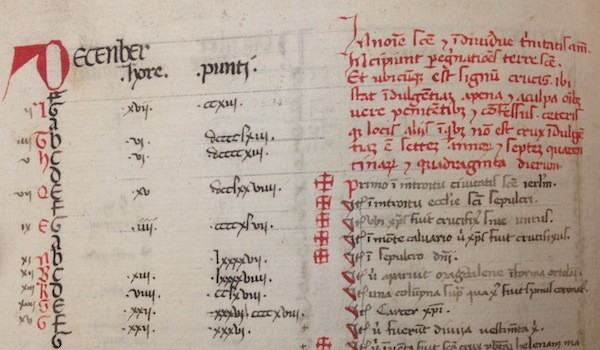Introducing: Beinecke MS 1153
Through the Holy Land and Back Again
Beinecke MS 1153, produced sometime after 1383*, is extraordinary for its breadth of materials, and its unique preservation of the pilgrimage of “Franceschinus,” a monk originally hailing from Pontemoli, Italy (in Tuscany). Due to the prominence of the Lives of St. Francis, St. Claire, and St. Anthony in the opening portion of the manuscript, this codex seems to have belonged to the Franciscan order. Primarily written in Latin, there are a number of vernacular materials: for example, the Life of the Virgin and the Life of Christ are both written in Italian, as is a poem of Judgement in octava rima and several writings by St. Bridget. This manuscript also includes a Latin account of the dedication of St. Laurence Cathedral in Genoa (f. 92r). This dedication of St. Laurence Cathedral is a likely indication of where this manuscript originally circulated, one that is corroborated below.
Of the contents in MS 1153, however, the most exciting find is a unique record of Franceschinus’ pilgrimage to the Holy Land. This account is introduced in the first person and contains detailed and specific information about distances traveled, sights visited, and costs incurred. This personal itinerary complements a depersonalized list of places to visit in Jerusalem, including a rudimentary code for calculating the indulgences received at each stop, found earlier in the codex on folio 133v (above image).
According to Franceschinus’ account, he set off on the 17th of February 1382, traveling 300 miles to reach Rome (almost the exact distance on modern roads between Genoa and Rome). The trip took him a month and a day: he arrived on March 18. After traveling across the Mediterranean, exploring the edges of Greece, and making pitstops at holy places along the way, Franceschinus arrived in Jerusalem on May 23. He crossed the Jordan and travelled to Bethlehem shortly thereafter.
After this travelogue of distances travelled, and places visited (f. 144v) comes a brief list of accounts on folio 145r. However, this is not a comprehensive list of expenses, but a list of money payed “saracenis” (to the Saracens), but not including what he spent on food and drink. Predominantly, this is a list of prices for entry into sacred sites across the Holy Land, including the cost of seeing where St. George was beheaded, crossing the Jordan, seeing St. Lazarus’ monument, and entering into the Holy Sepulcher. Although the list also includes the prices of some accommodations, including the rental of a donkey, it may be that Franceschinus betrays through this list his anxiety at how devotional pilgrimage paradoxically sustains the economy of Islamic society in Christian holy land.
*The date Franceschinus gives for his pilgrimage
*View the current catalogue entry.



